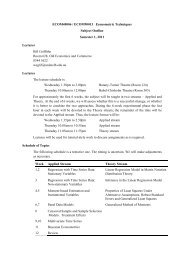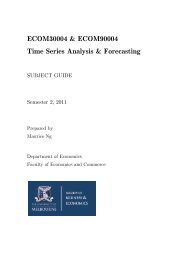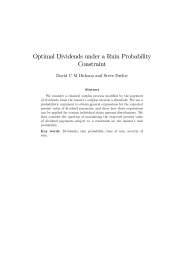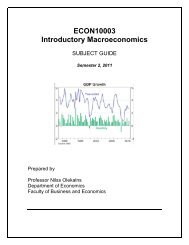A Model of Optimal Corporate Bailouts - Faculty of Business and ...
A Model of Optimal Corporate Bailouts - Faculty of Business and ...
A Model of Optimal Corporate Bailouts - Faculty of Business and ...
You also want an ePaper? Increase the reach of your titles
YUMPU automatically turns print PDFs into web optimized ePapers that Google loves.
• A “restarted” project proceeds much like in the first period, with the exceptionthat there are no additional restarts. Thus, the restarted project can either succeed(again yielding pay<strong>of</strong>f R) or fail (yielding pay<strong>of</strong>f 0), with the probability <strong>of</strong> successcorresponding to managerial effort at time 2, e 2 .• If the restarted project succeeds, the firm must pay the manager wages <strong>of</strong> w 2 ≥ 0<strong>and</strong> the government an (extraordinary) tax <strong>of</strong> T 2 ≥ 0. 7• The game ends, regardless <strong>of</strong> success or failure.We consider cases in which the parameters render it optimal for entrepreneurs to set upfirms at time 1 even without government subsidies. In real life, especially if other less elasticmarkets can be taxed, there may well be situations in which firms produce social externalitiesthat are high enough to warrant subsidies even when they do not run into trouble. However,this is not the problem that our model is analyzing.1.2 Additional AssumptionsThe manager bears a private cost <strong>of</strong> providing effort <strong>of</strong> c/2·e 2 , where c > 0 is assumedt“large” relative to other parameters. 8 Thus, single-period managerial utility at time t is m t =e t·w t − c·e 2/2.tIn designing its bailout policy, we require the government to break even actuarially. Thismeans that if it chooses to adopt a bailout policy (g > 0), then the government must be ableto raise sufficient revenues through taxes (T 1 <strong>and</strong> T 2 ) to finance the bailout. Our model thusreflects ? points that both the fund-raising (taxation) <strong>and</strong> the fund-distribution (bailouts) havewelfare costs. In reality, taxation could be more or less distortionary than it is in our model.In addition, taxes distort effort incentives in our model because wages are not tax-deductible.However, all our important results are robust even if the taxation funding welfare loss is zero<strong>and</strong> if wages are fully tax-deductible. 9Finally, we assume that there exists an additional public benefit S, which embodies thepay<strong>of</strong>f <strong>of</strong> other stakeholders if the firm succeeds. It is important that neither the firm nor themanager can capture their surplus, e.g., because they are too diffuse <strong>and</strong> heterogeneous. Inour basic model, the recipients <strong>of</strong> these benefits are also beyond the taxation power <strong>of</strong> thegovernment. (In Section 4.3, we discuss a variant <strong>of</strong> our model in which other parties, such asthe externality recipients, can be taxed.)In all, our framework contains five exogenous parameters, consisting <strong>of</strong> investment costsI 1 <strong>and</strong> I 2 , success-contingent revenues R, a managerial effort cost parameter c, <strong>and</strong> external7 Note that T 2 is an extraordinary tax only on bailed-out firms. (The model should be viewed as repeating both<strong>of</strong> its two stages in future periods. Thus, after any bailouts, firms will be taxed just like ordinary firms.)8 Specifically, we assume that c > (R + S). This is necessary <strong>and</strong> sufficient to keep the first-best effort below 1.9 In particular, the optimal tax T 2 continues to be zero, <strong>and</strong> the decision to retain or fire the manager remainsthe same. (To make wages tax-deductible, the gross pay<strong>of</strong>f in π 2 would change from R− T 2 −w 2 to (R−w)·(1−τ 2 )on Page 12.)9
















